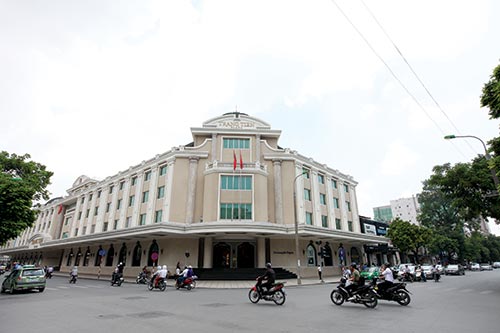Hanoi’s glossy shopping malls fail to lure customers
The
renovations of Trang Tien Plaza
and Hang Da Galleria in Hanoi
have sparked investor interest in upgrading existing trade centres into
modern luxury shopping centres.

Investors say luxury stores are key to drawing shoppers into the
city’s biggest malls, Photo: Duc Thanh
Major sales programmes are underway in the shops of Trang Tien Plaza,
prior to its second renovation, just 16 months after it reopened in April
2013. Previously it was renovated after it was sold to a new investor, who
reportedly poured VND400 billion ($19 million) into renovating it. Considered
a commercial symbol of the capital city over the last 100 years, any change
to Trang Tien Plaza
is sure to capture the public’s attention.
The mall was called Godard House when it was first
established in the French colonial period. Since 1959 the department store
was totally owned by the state. Then it entered a new period when it opened
again last year, targeting high-income customers. Particularly, it was
renovated by famous businessman Jonathan Hanh Nguyen, who is the chairman of
Imex Pan Pacific – IPP, currently the distributor of a number of luxury brand
names in Vietnam.
Despite attractive discounts, the stalls at Trang Tien Plaza
are deserted. People only go to the mall to window-shop or take pictures, but
they don’t actually intend to buy any of the luxury items on sale there.
High prices are the main reason local buyers are
staying away. Located in the most advantageous corner of Hanoi, the retail premises cost over $100
per square metre per month, or triple the market average.
Despite the fact that few customers are able to afford
the high-end products on offer at Trang
Tien Plaza,
Nguyen Thi Ngoc Dung, general director of Trang Tien Trading and Investment
Company confirmed that the shopping centre, after renovations, would stay
true to its current high-end market segment.
“Luxury products and high-end trade centres are the
development trend of the world, and therefore we believe this also to be true
for Trang Tien Plaza,”
Dung said. “But we will re-plan the whole of the building so that it is not
exclusively luxury products, but also a variety of others, that meet the
different needs of customers.”
The restructuring of Trang Tien
Plaza is an outlier in
the market. It has shown that despite a golden location and investors with
financial capability, a project can still be unsuccessful.
Parkson at Keangnam is also very quiet, with many
sellers having hung out discount signage.
Another notable case, Hang Da Galleria (now called Hanoi Square) has
been renovated twice over the last several years. From a wet market building
in the French period, it was rebuilt into a modern shopping centre in 2011.
However, it suffered from too few visitors and the developer was forced to
again renovate the building, with the goal to offer more affordable products.
Perhaps the worst was the closing of the Grand Plaza after only a year of operation.
This shopping mall suffered from a poor business strategy as well.
According to Leanne Mitchell, CBRE Asia director for
Asset Management, managing a trade centre is an art form. In order to make
them successful, owners must have a keen eye for the market.
“They have to understand which customers they are
serving, adapt to consumption trends, be knowledgeable about lifestyle and
customer’s incomes, then they can determine which market segment they should
target,” Mitchell said.
Retail space in trade centres in Hanoi in the first half of the year didn’t
grow much. According to CBRE Vietnam, the capital currently has the total
stock of around 600,000 square metres in 20 shopping centres, two department
stores, and eight retail podiums.
By Bich Ngoc, VIR
|
Không có nhận xét nào:
Đăng nhận xét